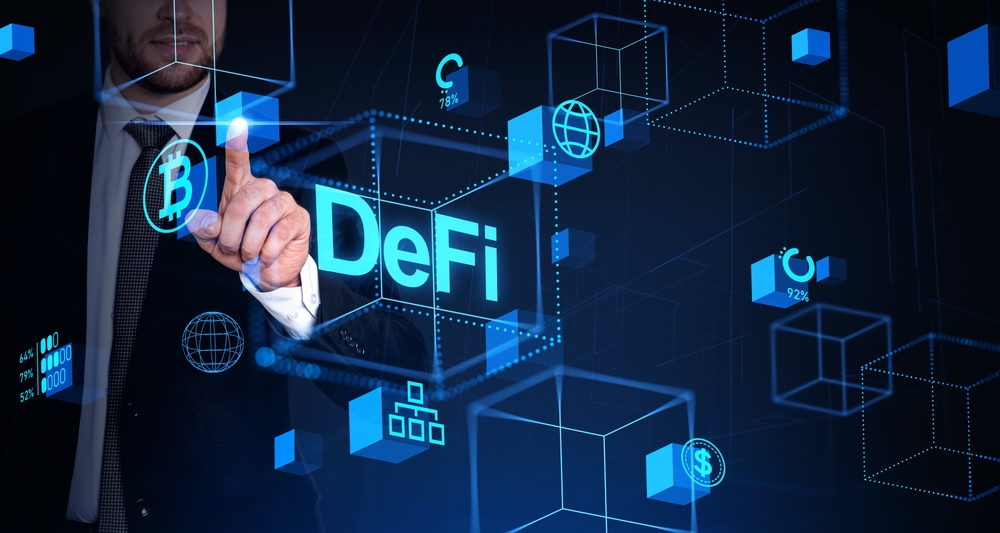The Rise of DeFi: How Decentralized Finance is Shaping the Crypto World

Feeling the pinch every time you engage with your bank or broker? We’re navigating through a sprawling maze of fees and regulations, often feeling more like pawns than players in the vast game of finance. But what if there was an alternative that turned the tables, putting you in the driver’s seat with lower costs and decentralized control? This is the promise of Decentralized Finance, or DeFi—a burgeoning domain that’s reshaping the financial landscape by leveraging blockchain’s prowess. By sidestepping traditional intermediaries and embracing user autonomy, DeFi is not just a fleeting trend; it’s a potent solution, offering a glimmer of hope for a more inclusive and empowering financial future. Let’s prepare to explore this dynamic space—where financial democracy isn’t a lofty ideal but an accessible reality, making strides in breaking down long-established barriers.
Is your wallet taking a hit with every financial move you make? Ever noticed the labyrinth you need to navigate just to understand a simple finance service? You’re not alone. Our global finance system, while vast and intricate, is full of challenges that many of us face on a daily basis. But what if there was a different way? Imagine a financial system with more accessibility, lower costs, and user-driven innovation. Well, it’s not just imagination anymore – welcome to the world of Decentralized Finance, commonly known as DeFi.
The Problems with Traditional Finance

Let’s take a step back and look at the traditional financial ecosystem – a scenario many of you are all too familiar with:
- High transaction fees that nibble away at your savings
- Layers of intermediaries, from banks to brokers, all taking their cut
- A sometimes impenetrable fortress of regulations that can make you feel like you need a law degree to get a loan
It’s a setup that’s not always built around user needs but rather, a complex structure profiting from them. Now, let’s bring DeFi into the picture – a realm where the power shifts back to the people. With the integration of blockchain technology, DeFi promises a seismic shift in how we interact with money, investments, and each other financially.
Hope in DeFi
Swooping in like a financial superhero, DeFi comes armed with its arsenal of peer-to-peer services, aiming to dismantle the barriers erected by conventional finance. Here’s how DeFi lights up the path to change:
- Access for All: Regardless of who you are or where you are, DeFi opens doors to financial services through the simple requirement of an internet connection.
- Lower Overhead Costs: By stripping out the middlemen, DeFi slashes the fees and offers more attractive rates for savers and borrowers alike.
- User Empowerment: DeFi places control into the hands of its users, granting autonomy and the ability to directly participate in financial markets.
These highlights are merely scratching the surface. What’s truly captivating is the underlying potential DeFi holds to overhaul the problematic aspects of traditional finance that have plagued consumers and investors for too long. Does it sound too good to be true? That’s a fair question, and one that warrants a deeper exploration into the fabric of DeFi – which, by the way, is exactly what we’ll be doing next. Are you ready to unveil how DeFi works and why it stands tall against the aged giants of traditional finance? Stay tuned as we unravel the pillars that fortify this innovative financial frontier in Part 2.
Understanding DeFi and Its Impact

The fintech revolution has ushered us into an era where the traditional gatekeepers of finance are being challenged. Standing at the forefront is Decentralized Finance (DeFi)—a system that’s all the more intriguing for its promise of financial democracy. Its allure? Prying open the once iron-clad doors to financial services and sprucing up the antiquated processes we’ve come to begrudgingly accept.
How does DeFi work?
At its core, DeFi simplifies financial transactions. Imagine being your own bank, where you get to call the shots. Here’s how it transcends expectations:
- Negotiable interest rates: No need to acquiesce to the bank-dictated terms; interest rates in DeFi are dynamic and can be negotiated directly between peers.
- Peer-to-peer lending: Contrast this with traditional banking, and you’ll find an unrestricted lending market, free from institutional constraints, where lending is made simplistic and direct.
DeFi’s Advantage Over Traditional Systems
Now, let’s pull up a chair and size up DeFi alongside traditional finance. It doesn’t take much to see the disparity:
- Lower fees: Ever been stung by those pesky transaction fees? DeFi snips those down significantly.
- Better interest rates: In the realm of savings and loans, DeFi platforms often offer more lucrative rates than their institutional counterparts.
- Transparency: This is where DeFi shines, as all transactions are stored on the blockchain, visible for anyone to verify—a stark contrast to the often opaque practices of traditional banks.
Real examples pepper the landscape of DeFi, demonstrating its impact. Take, for instance, protocols like Uniswap or Aave, which empower users to exchange tokens or borrow against their crypto assets without an intermediary. The result? Cost savings, time efficiency, and the democratization of finance.
“In a world where trust is currency, DeFi earns it through transparency and inclusivity.”
But can this really be the panacea to our financial system ailments? Some studies suggest a bold yes, with data reflecting an exponential increase in DeFi adoption. Users from around the globe are not only showing interest but also participating in DeFi platforms, signaling a shift in the tide of financial services.
Curious about how this could reshape the entire landscape of modern finance? Well, what if I told you that it has the potential to empower millions of unbanked individuals and offer unprecedented access to financial services?
Keep that thought, because as we peel back the layers of DeFi, we find its impact might just ripple further than we can see. Stay tuned as we explore how it’s breaching the barriers to financial inclusion in the upcoming section.
The Role of DeFi in Changing the Finance Landscape

When we talk about the shifts happening right now in the financial stratosphere, DeFi isn’t just a drop in the ocean. It’s a torrent reshaping the landscape that we’ve grown so accustomed to. But how exactly is it stirring the financial waters? Let’s dive in with some real-world examples and substantive research that illuminate DeFi’s transformative power.
Empowering the Unbanked
One of the most profound ways DeFi is rewriting the rules is by empowering the unbanked population. There are billions of people worldwide without access to a bank account, denied the fundamental financial services many of us take for granted. However, DeFi is ripping up the rulebook. With a simple internet connection, anyone can now access banking services. Imagine a farmer in a remote village securing a loan directly from an investor across the globe, or a teenager receiving payments for online services without ever stepping foot into a bank building. These aren’t just theoretical scenarios; they are happening as we speak.
- A farmer in Nigeria can now sell his produce and immediately get access to his funds through a DeFi platform without waiting days for bank processing.
- A software developer in Venezuela escapes hyperinflation by earning in and safeguarding their income in a DeFi saving account—something that would have been unthinkable with a local bank.
Better Financial Transparency
Transparency is the cornerstone upon which the towering structure of DeFi is built. Unlike traditional finance, where transactions can be as opaque as a bank vault, DeFi platforms operate on blockchain technology. This means every transaction is recorded on a public ledger, accessible to anyone, anytime. As famously quoted by Don Tapscott,
“Blockchain is the ultimate open-source dissemination of value.”
DeFi dismantles any veils of secrecy, allowing us to track, trace, and trust in a system that has nothing to hide.
Take for instance, ‘smart contracts’ — self-executing contracts with the terms of the agreement directly written into code. They execute automatically when conditions are fulfilled, and because they’re on the blockchain, there’s no room for ‘creative accounting’ or hidden fees. It’s a level of transparency traditional finance can’t match. Studies suggest this could significantly reduce fraud, corruption, and mismanagement of funds, heralding a new era of trust in finance.
Still, it’s not all smooth sailing on the open seas of DeiFi. We must not overlook the complexities and technological barriers that still exist. But the question hanging in the air is inevitable: Can DeFi continue to stand strong against the tides of change? Stay tuned as we dissect further the potential and pitfalls in a financial revolution that could very well be the answer to a fairer and more transparent economy.
DeFi: The Future of Finance?

Is Decentralized Finance (DeFi) the harbinger of a new era in the financial domain? Consider this. We’re looking at a horizon ripe with endless possibilities, where systems serve the people, not the other way around. The potential of DeFi to overhaul the cobweb-covered structures of traditional finance is not just some wild speculation; it’s a tangible, emerging reality.
Recognizing the Potential of DeFi
Imagine a world where you are in complete control of your financial destiny – no middlemen, no convoluted fine prints, and services that cater globally. That’s the vision DeFi brings to the table. By leveraging blockchain technology, DeFi offers a plethora of financial instruments without the need for centralized institutions. We’ve seen real samples of its potential through:
- Peer-to-peer lending platforms that connect borrowers and lenders directly, offering more competitive interest rates than traditional banks.
- Decentralized exchanges (DEXs) where users trade digital assets directly with each other, bypassing the need for a central authority to oversee trades.
- “Yield farming,” where users can earn returns on their crypto holdings by contributing to liquidity pools or staking in various DeFi protocols.
A study by the Cambridge Centre for Alternative Finance reports the staggering growth of DeFi services, with billions of dollars locked in smart contracts. It’s more than a wave; it’s a changing tide.
The Risks Involved
Yet, for all its promise, DeFi isn’t a golden ticket without pitfalls. With innovation comes the potential for missteps. Hacking and scams have been known to occur, with some users losing significant sums to these risks. Regulation, or the current lack thereof, also poses questions on legality and security. This burgeoning realm demands our cautious footprints as we navigate its unfolding landscape.
“Risk comes from not knowing what you’re doing.” – Warren Buffet
Buffet’s words ring eerily true in the context of DeFi. As we embrace this revolution, understanding the landscape not only shields us against potential risks but guides us to make informed, strategic decisions. Acknowledging the risks is not to dissuade but to arm oneself with the necessary caution and knowledge.
So, where does that leave us as we venture further into this adventurous financial territory? Are you ready to be part of a change that puts you at the helm of your financial future? Continue exploring with me and uncover crucial resources that will illuminate the path ahead.
Stay tuned, as we’ll unveil in the next segment the key resources to get you further acquainted with DeFi, and answer the burning question: How can you safely navigate the dynamic waters of decentralized finance?
Resources to Explore More About DeFi

Curious about the doors DeFi is opening in the financial world? There’s a wealth of knowledge out there waiting to be uncovered. Below, I’ve compiled a must-see collection of materials that delve deep into the revolutionary world of Decentralized Finance, giving you insights and perspectives that will leave you both informed and intrigued.
Decentralized Finance (DeFi): Revolutionizing the Financial Landscape
One article that sparks significant interest is “Decentralized Finance (DeFi): Revolutionizing the Financial Landscape” found on thepaymentsassociation.org. It’s a compelling read that sheds light on how Blockchain is the keystone in building a new, democratic financial structure. The piece explores the transformative potential of DeFi and how it’s positioned to redesign our current financial models.
The Rise of Decentralized Finance
Additionally, the thought-provoking insights on LinkedIn’s article “The Rise of Decentralized Finance” offer a brilliant perspective on what lies ahead for our financial systems. It’s a deep dive into DeFi’s benefits and a refreshing take on how it can challenge the status quo of today’s financial norms.
Both pieces are laden with real-world examples and even back up their claims with studies, painting a vivid picture of the DeFi landscape. They don’t just theorize; they analyze trends and data, giving us a clear view of the DeFi revolution’s trajectory.
Now, what impact could this have on your own interactions with the world of finance? Might DeFi alter your investment strategies, or perhaps influence your business dealings? As we edge closer to a decimalized future, it’s smart to keep abreast with these dynamic changes.
But how do you navigate this brave new world with confidence and caution in equal measure? Stay tuned, as in the next segment, I’ll share critical insights that might just guide your next big decision in the realm of DeFi.
Final Thoughts

As we take a step back from the granular details and individual stories of success and challenge within the decentralized finance (DeFi) ecosystem, a vivid picture begins to emerge. The innovation of DeFi isn’t just a fleeting trend; it’s a robust movement poised to disrupt the rigid structures of traditional banking. It’s clear that we stand on the precipice of a major shift, where the promise of financial inclusion, transparency, and reduced operational costs beckon us toward a new horizon.
Analyzing DeFi’s Impact
It’s an exciting time to witness the financial world evolve. The expansion of DeFi has the potential to democratize finance on an unprecedented scale. Imagine a landscape where seamless peer-to-peer transactions are not just a possibility but a daily reality. Imagine lending and borrowing without the labyrinth of red tape, where your economic worth isn’t determined by your geographic location or the whim of a banking institution. Now, stop imagining because this is the world DeFi is crafting right before our eyes.
Real-world examples abound, demonstrating DeFi’s momentum. For instance, recent studies highlight a surge in users adopting decentralized exchanges (DEXs), fascinated by the prospect of swapping assets without a middleman. It’s not mere speculation; it’s tangible expansion, drawing closer to an ecosystem where economic power is returned to individuals.
DeFi: Yes or No?
So, the burning question at the forefront of our minds is, should we embark on the DeFi journey? The candid answer echoes with a cautious, yet optimistic “Yes.” The scaffolding of DeFi’s architecture offers a vision too compelling to dismiss. DeFi isn’t without its conundrums, bearing issues like smart contract vulnerabilities and scalability barriers. However, the solutions are continually iterated upon by some of the brightest minds in our sector. It’s an innovation in finance that’s not just smart; it’s necessary.
Wrapping Up
Summing up this exploration, the trajectory for DeFi suggests a robust potential to reset our expectations of what a financial system can be. Yet, let’s not don rose-tinted glasses; there will be obstacles, dips, and turns in this road to reform. What’s commendable isn’t just the aspiration for a reimagined financial world, but the iterative, resilient response of the DeFi community to challenges faced.
The wisest path forward is one where we stay both informed and adaptable. The seeds have been planted, and the DeFi tree is growing, roots deepening in a fertile ground of innovation and a thirst for equitable finance. So keep an eye on this space, for the future of finance isn’t just a dream—it’s unfolding right here, right now, and it is thrilling, to say the least.
